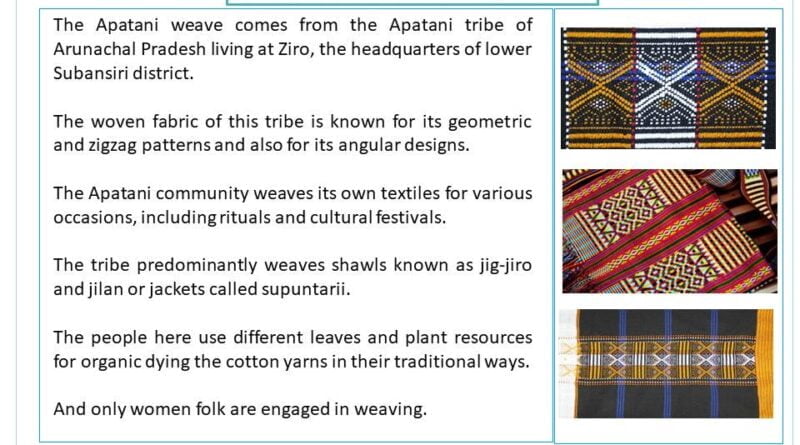Arunachal Pradesh Apatani Textile Product
Context:
Recently, an application seeking Geographical Indication (GI) tag for the Arunachal Pradesh Apatani textile product has been filed by a firm.
Contents
Apatani textile product
- The Apatani weave comes from the Apatani tribe of Arunachal Pradesh living at Ziro, the headquarters of lower Subansiri district.
- The woven fabric of this tribe is known for its geometric and zigzag patterns and also for its angular designs.
- The Apatani community weaves its own textiles for various occasions, including rituals and cultural festivals.
- The tribe predominantly weaves shawls known as jig-jiro and jilan or jackets called supuntarii.
- The people here use different leaves and plant resources for organic dying the cotton yarns in their traditional ways.
- And only women folk are engaged in weaving.
What makes it special?
- The people here use different leaves and plant resources for organic dying the cotton yarns in their traditional ways.
- Only women folk are engaged in weaving.
Apatani Tribe
- Arunachal Pradesh is a land of rich cultural heritage and tradition that stems from the presence of the various tribes indigenous to the state.
- One of the larger tribes is the ‘Apatani’ who are known for their fish and paddy culture, along with cane and bamboo crafts.
- With being the first tribe in India to come in contact with the British in the 12th century, various documents record the growth and tradition of the Apatanis over a number of years.
- The elders in the tribe propagate knowledge through folk stories, songs, couplets in the form of Miji-Migun, Busi-Ayu and also extensive and elaborate festivals like Marun, Myako, Dree, and Yapung.
- The Apatanis speak a local language called Tani and worship the sun and the moon.
- Local ritual specialists also take part in chanting, blood-letting and animal sacrifices in a bid to keep the inhabitants healthy.
Geographical Indication (GI) Tag
- About:
- A Geographical Indication (GI) is a sign used on products that have a specific geographical origin and possess qualities or a reputation that are due to that origin. In order to function as a GI, a sign must identify a product as originating in a given place.
- It is used for agricultural, natural and manufactured goods.
- International Protection for GI:
- Internationally GI are covered as a component of Intellectual Property Rights (IPRs) under the Paris Convention for the Protection of Industrial Property.
- The Paris Convention, adopted in 1883, applies to industrial property in the widest sense, including patents, trademarks, industrial designs, utility models, service marks, trade names, geographical indications and the repression of unfair competition.
- GI is also governed by the World Trade Organisation’s (WTO’s) Agreement on Trade-Related Aspects of Intellectual Property Rights (TRIPS).
- Internationally GI are covered as a component of Intellectual Property Rights (IPRs) under the Paris Convention for the Protection of Industrial Property.
- GI Protection in India:
- India, as a member of the World Trade Organisation (WTO), enacted the Geographical Indications of Goods (Registration & Protection) Act, 1999 which came into force with effect from 2003.
- The Act provides registration and also protection of GI goods in India.
- This Act is administered by the Controller General of Patents, Designs, and Trademarks, who is also the Registrar of Geographical Indications.
- The Geographical Indications Registry for India is located in Chennai.
- The registration of a geographical indication is valid for a period of 10 years. It can be renewed from time to time for a further period of 10 years each.
- Some of the examples of Geographical Indications in India include basmati rice, Darjeeling tea, Kancheepuram silk saree, Nagpur orange and Kolhapuri chappal.
- India, as a member of the World Trade Organisation (WTO), enacted the Geographical Indications of Goods (Registration & Protection) Act, 1999 which came into force with effect from 2003.
- Benefit of GI tag:
- Once the GI protection is granted, no other producer can misuse the name to market similar products. It also provides comfort to customers about the authenticity of that product.
- Having a GI tag for a product prevents unauthorised use of a registered Geographical Indication by others, boosts exports of Indian Geographical indications by providing legal protection and also enables seeking legal protection in other WTO member countries.
Present GI Products from Arunachal Pradesh
- Arunachal Orange (Agricultural)
- Idu Mishmi Textiles (Handicraft)
Tribes of Arunachal Pradesh
- The tribes of Arunachal Pradesh include: Abor, Aka, Dafla, Galong, Khampti, Khowa, Mishmi, Monpa, Momba, Any Naga tribes, Sherdukpen, Singpho.
Source: The Hindu


